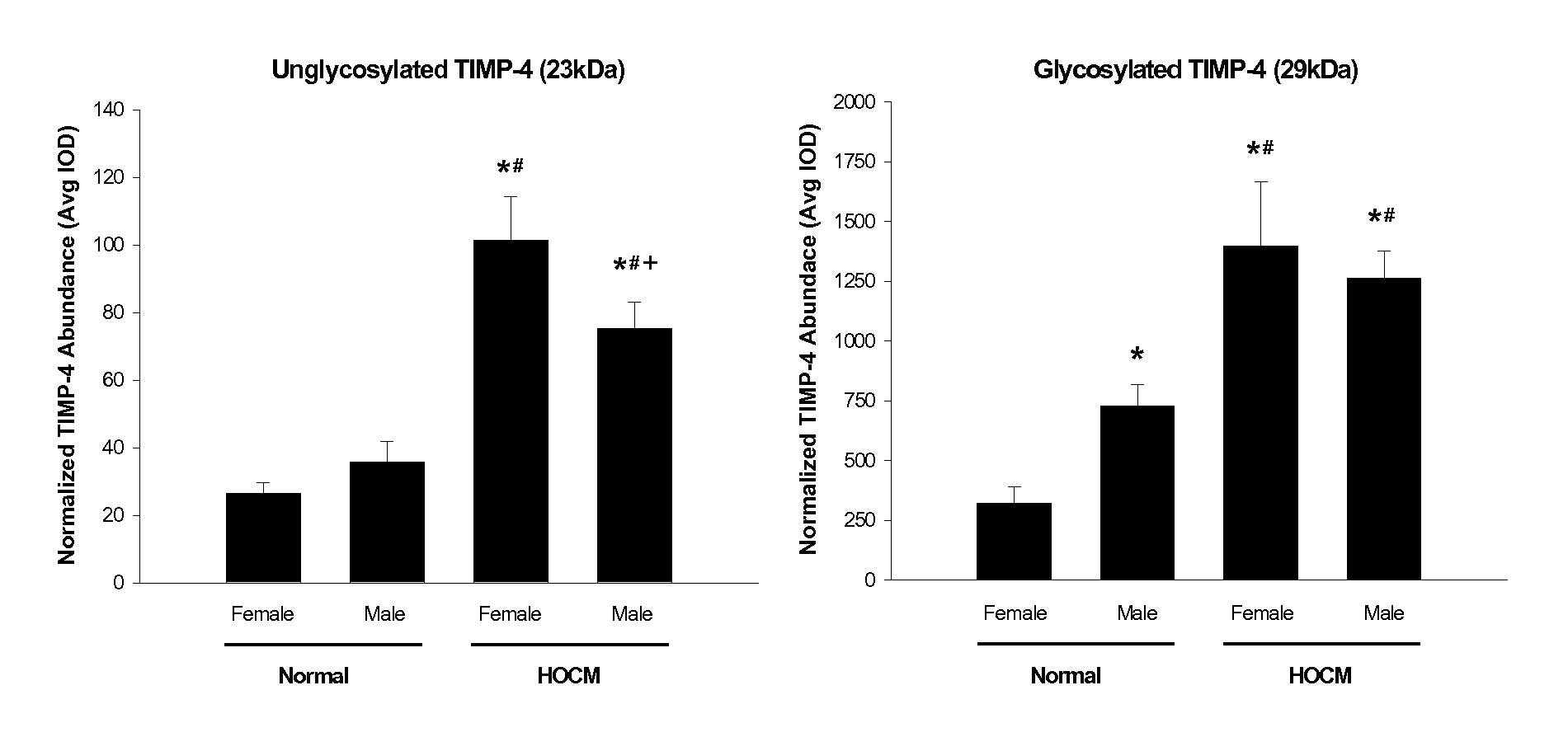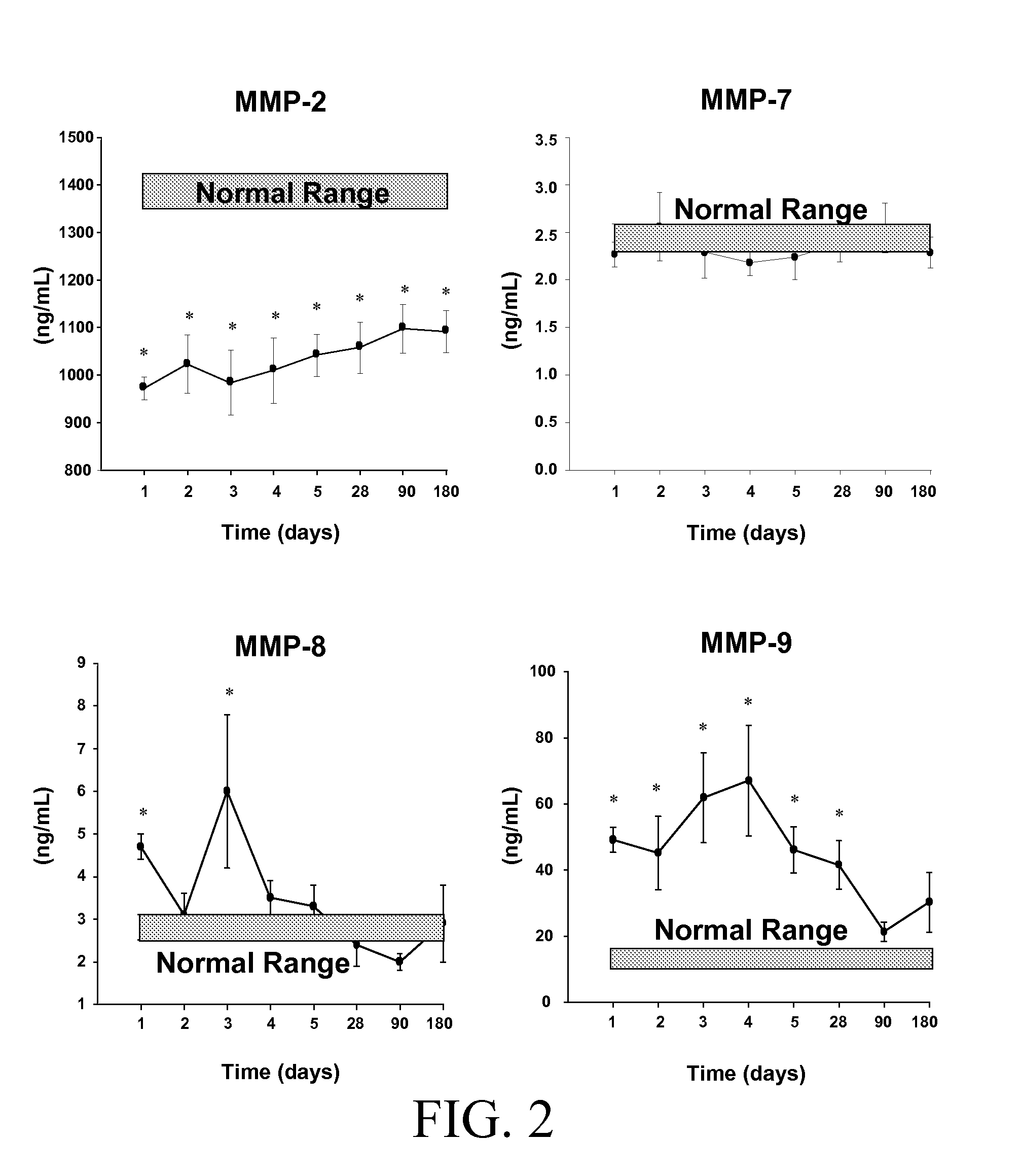Predicting Heart Failure Following Myocardial Infarction by Protease and Protease Inhibitor Profiling
a protease inhibitor and profiling technology, applied in the direction of biological material analysis, instruments, biochemistry apparatus and processes, etc., can solve the problems of inability to achieve the best identifying method of patients at the greatest risk of developing post, inability to remodel, and inability to achieve the identifying method
- Summary
- Abstract
- Description
- Claims
- Application Information
AI Technical Summary
Benefits of technology
Problems solved by technology
Method used
Image
Examples
example 1
1. Example 1
Specific Temporal Profile of Matrix Metalloproteinase Release in Patients Following Myocardial Infarction: Relation to Left Ventricular Remodeling
[0188]Conclusions: A specific temporal pattern of MMP / TIMPs occurred in post-MI patients which included an early and robust rise in MMP-9 and MMP-8, a late increase in TIMP-2 and a uniform fall in cardiac specific TIMP-4. These unique findings show that a specific MMP / TIMP plasma profile occurs post-MI which holds both prognostic and diagnostic significance.
Methods
[0189]Subjects: Thirty-two patients with a confirmed myocardial infarction (MI) and 53 reference control subjects were enrolled in this study after obtaining informed consent. Confirmation of an MI was by electrocardiography and a positive cardiac enzyme panel. The criteria for enrollment as an MI subject was a troponin-I value which was 2.5 times greater than the laboratory reference value recorded within 48 hours from the time of presentation to the emergency depart...
example 2
2. Example 2
Release of Matrix Metalloproteinases Following Alcohol Septal Ablation in Hypertrophic Obstructive Cardiomyopathy
[0207]This study examined plasma levels of certain MMP and TIMP species before and after alcohol induced MI in patients with hypertrophic obstructive cardiomyopathy (HOCM).
[0208]Methods and Results: Plasma levels for the gelatinases, MMP-2 and MMP-9, and for the collagenases MMP-8 and MMP-13, as well as TIMP-1 profiles (by ELISA) were obtained at baseline and serially up to 60 hours following alcohol injection into the septal perforator artery in order to induce an MI in 51 patients with HOCM (age 55±2 yrs). Plasma creatine kinase (MB isoform), indicating myocardial injury, increased 2150% 18 hrs post MI (p<0.05). Plasma MMP-9 increased by over 400% and MMP-8 by over 100% from baseline values by 12 hrs post-MI (p<0.05 vs baseline). A similar temporal profile was not observed for MMP-2 and MMP-13. In addition, a concomitant increase in plasma TIMP-1 levels did ...
example 3
3. Example 3
Plasma Monitoring of MMP-4 Following Alcohol Septal Ablation in Hypertrophic Obstructive Cardiomyopathy
[0223]Objectives: The overall goal of this study was to develop a semi-quantitative assay procedure for measuring the relative abundance of TIMP-4 in plasma, and then utilize this approach to determine dynamic changes of TIMP-4 levels in hypertrophic obstructive cardiomyopathic (HOCM) patients following an acute myocardial infarction (MI).
[0224]Methods / Results: Plasma TIMP-4 levels were examined (by semi-quantitative immunoblotting) in normal (n=18) and HOCM (n=16) patients following alcohol-induced MI. Serial measurements of plasma TIMP-4 levels were examined up to 60 hours following alcohol-induced MI in patients with HOCM. Unglycosylated plasma TIMP-4 levels increased 250% in the HOCM patients when compared to normal controls. Total plasma TIMP-4 levels decreased by 20% at 30 hrs following alcohol-induced MI.
[0225]Conclusion: The unique results demonstrated that an i...
PUM
| Property | Measurement | Unit |
|---|---|---|
| molecular weight | aaaaa | aaaaa |
| time | aaaaa | aaaaa |
| time | aaaaa | aaaaa |
Abstract
Description
Claims
Application Information
 Login to View More
Login to View More - R&D
- Intellectual Property
- Life Sciences
- Materials
- Tech Scout
- Unparalleled Data Quality
- Higher Quality Content
- 60% Fewer Hallucinations
Browse by: Latest US Patents, China's latest patents, Technical Efficacy Thesaurus, Application Domain, Technology Topic, Popular Technical Reports.
© 2025 PatSnap. All rights reserved.Legal|Privacy policy|Modern Slavery Act Transparency Statement|Sitemap|About US| Contact US: help@patsnap.com



